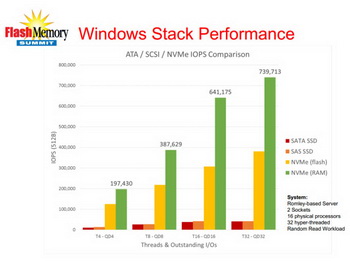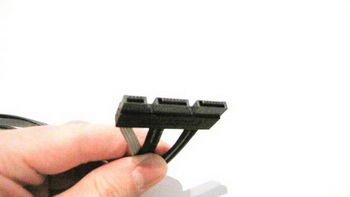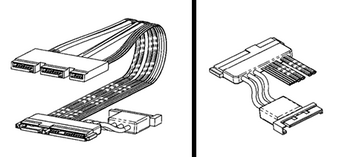OOPS! You forgot to upload swfobject.js ! You must upload this file for your form to work.
SATA Express pre-test
![]()
|
xtreview is your : Video card - cpu - memory - Hard drive - power supply unit source |
|
|||
|
|
||||
 Recommended : Free unlimited image hosting with image editor
Recommended : Free unlimited image hosting with image editor
|
POSTER: computer news || SATA EXPRESS PRE-TEST |
DATE:2014-03-14 |
|
|
AnandTech published extensive article entitled Testing SATA Express and why we need a fast SSD. First, more efficient drives can quickly perform the task , reducing the average consumption and extend battery life . Second, work with video streaming resolution 4K (3840 x 2160, 12-bit RGB) in the case of uncompressed video requires bandwidth to 900 MB / s. In the case of processing multiple streams of compressed video immediately even exceed the capabilities of modern interfaces. Of course, there is always a RAID, but it is more expensive than a single high-speed SSD. Third, should you move to a software interface AHCI (Advanced Host Controller Interface) interface NVMe (Non-Volatile Memory Express). The main requirement is to be achieved, this decrease delays when accessing SSD from 6 ms to 2.8 ms. Also, due to be fully used NVMe processor, since the depth of the queue and the team expanded to 64 thousand operations.  In the short term SSD become faster by switching to interface SATA Express (SATAe). Resource received for testing of pre-production motherboard ASUS - modification Z87 Deluxe controller SATAe ASMedia ASM106SE. As a test used SSD drive Plextor 256GB M6e PCIe SSD (Controller Marvell 88SS9183), which has an interface PCIe 2.0 x2. To simulate the interface SATAe used a special daughterboard. As demonstrated by testing, delays in handling the processor to drive almost was not. Both involved the line PCI Express 2.0 work at speeds close to effective.  Add to interface SATAe on board was the pilot used a composite of three independent cable connectors, which in the final version will become a cable with a common block. SATA-drives for compatibility cables continue, whereas PCIe-standard drives SATAe need extended cables. Also, these cables will receive an additional connector for external power supply as standard SATAe not available supply voltage through a common interface, as was done in the case of a familiar interface PCI Express. This means that the cables are a bit more expensive .  Related Products : | ||
|
|
||
|
xtreview is your : Video card - cpu - memory - Hard drive - power supply unit source |
|
|
|
|
||
|
Xtreview Support  N-Post:xxxx Xtreview Support        |
SATA EXPRESS PRE-TEST |
| Please Feel Free to write any Comment; Thanks  |
The external case with the Thunderbolt 3 interface can accept up to three drives with PCI Express interface (2017-08-08)
NVIDIA Tesla V100 will be offered in the version with PCI Express 3.0 interface (2017-06-21)
Developers accelerate the development of PCI Express 5.0 specifications (2017-06-11)
Supercomputer based on NVIDIA Volta will support PCI Express 4.0 (2017-05-22)
AMD intricately expresses its satisfaction with the level of performance of Vega (2017-04-24)
PCI Express extension for removing the video card from the motherboard (2017-04-13)
AMD X370 chipset adds support for two PCI Express x16 connector (2016-09-27)
PCI Express 4.0 will allow to pass through the interface connector up to 300 W (2016-08-22)
Samples of devices with support for PCI Express 4.0 are already (2016-08-20)
NVM Express protocol is now working on Ethernet network and other channels (2016-06-12)
MediaTek Pump Express 3.0 will charge a smartphone from 0 to 70 in 20 minutes (2016-06-02)
Zotac presented the video card GeForce GT 710 PCI Express x1 interface (2016-04-22)
Amazon will start to increase its fleet to express large airliners (2016-03-10)
Zotac introduced SONIX SSD PCI Express (2016-02-25)
ZOTAC announces SSD PCI Express x4 (2016-01-05)
Asus introduced new motherboard on chipset Intel B150 Express (2015-11-11)
Gigabyte Z170N-Gaming 5 Motherboard with armored connector PCI Express x16 (2015-09-01)
The final version of the standard PCI Express 4.0 will be approved by the beginning of 2017 (2015-07-07)
The introduction of drone couriers will allow Amazon to reduce the cost of express delivery up to 1 dollars (2015-04-13)
Intel introduced the SSD-drives 750 series 1.2 TB, NVMe and PCI-Express 3.0 (2015-04-04)
![]()
To figure out your best laptops .Welcome to XTreview.com. Here u can find a complete computer hardware guide and laptop rating .More than 500 reviews of modern PC to understand the basic architecture


7600gt review
7600gt is the middle card range.
We already benchmarked this video card and found that ...

 geforce 8800gtx and 8800gts
geforce 8800gtx and 8800gts  Xtreview software download Section
Xtreview software download Section  AMD TURION 64 X2 REVIEW
AMD TURION 64 X2 REVIEW  INTEL PENTIUM D 920 , INTEL PENTIUM D 930
INTEL PENTIUM D 920 , INTEL PENTIUM D 930  6800XT REVIEW
6800XT REVIEW  computer hardware REVIEW
computer hardware REVIEW  INTEL CONROE CORE DUO 2 REVIEW VS AMD AM2
INTEL CONROE CORE DUO 2 REVIEW VS AMD AM2  INTEL PENTIUM D 805 INTEL D805
INTEL PENTIUM D 805 INTEL D805  Free desktop wallpaper
Free desktop wallpaper  online fighting game
online fighting game  Xtreview price comparison center
Xtreview price comparison center Lastest 15 Reviews


Rss Feeds
Last News
- The new version of GPU-Z finally kills the belief in the miracle of Vega transformation
- The motherboard manufacturer confirms the characteristics of the processors Coffee Lake
- We are looking for copper coolers on NVIDIA Volta computing accelerators
- Unofficially about Intels plans to release 300-series chipset
- The Japanese representation of AMD offered monetary compensation to the first buyers of Ryzen Threadripper
- This year will not be released more than 45 million motherboards
- TSMC denies the presentation of charges from the antimonopoly authorities
- Radeon RX Vega 64 at frequencies 1802-1000 MHz updated the record GPUPI 1B
- AMD itself would like to believe that mobile processors Ryzen have already been released
- AMD Vega 20 will find application in accelerating computations
- Pre-orders for new iPhone start next week
- Radeon RX Vega 57, 58 and 59: the wonders of transformation
- ASML starts commercial delivery of EUV-scanners
- The older Skylake processors with a free multiplier are removed from production
- Meizu will release Android-smartphone based on Helio P40
- AMD Bristol Ridge processors are also available in American retail
- The fate of Toshiba Memory can be solved to the next environment
- duo GeForce GTX 1080 Ti in GPUPI 1B at frequencies of 2480-10320 MHz
- New Kentsfield overclocking record up to 5204 MHz
- Lenovo released Android-smartphone K8

HALO 3 HALO 3 - Final Fight!

PREY Prey is something you don t often see anymore: a totally unigue shooter experience.

computer news computer parts review Old Forum Downloads New Forum Login Join Articles terms Hardware blog Sitemap Get Freebies


